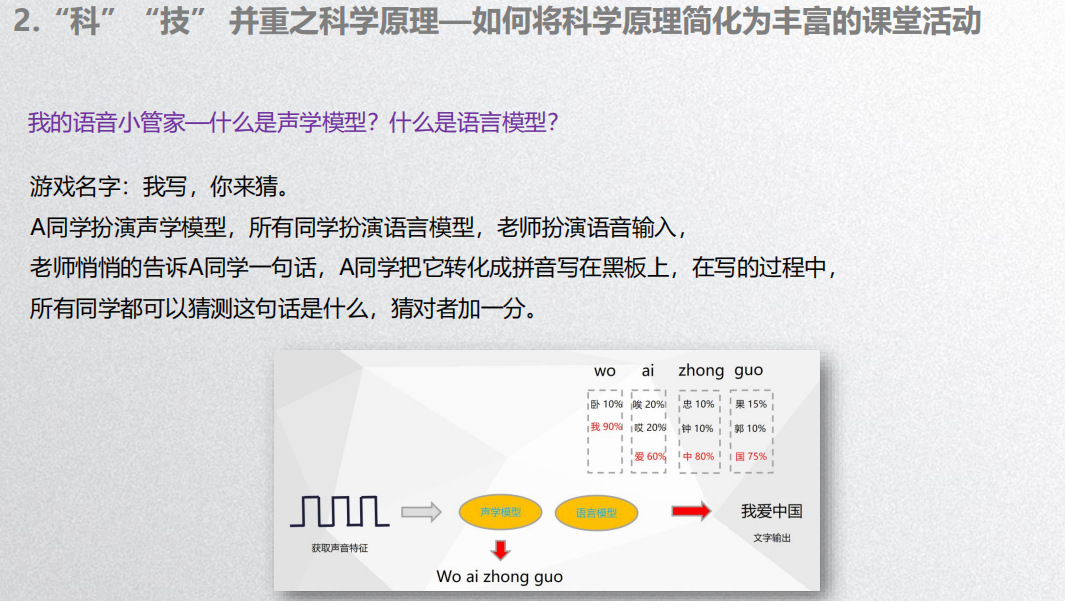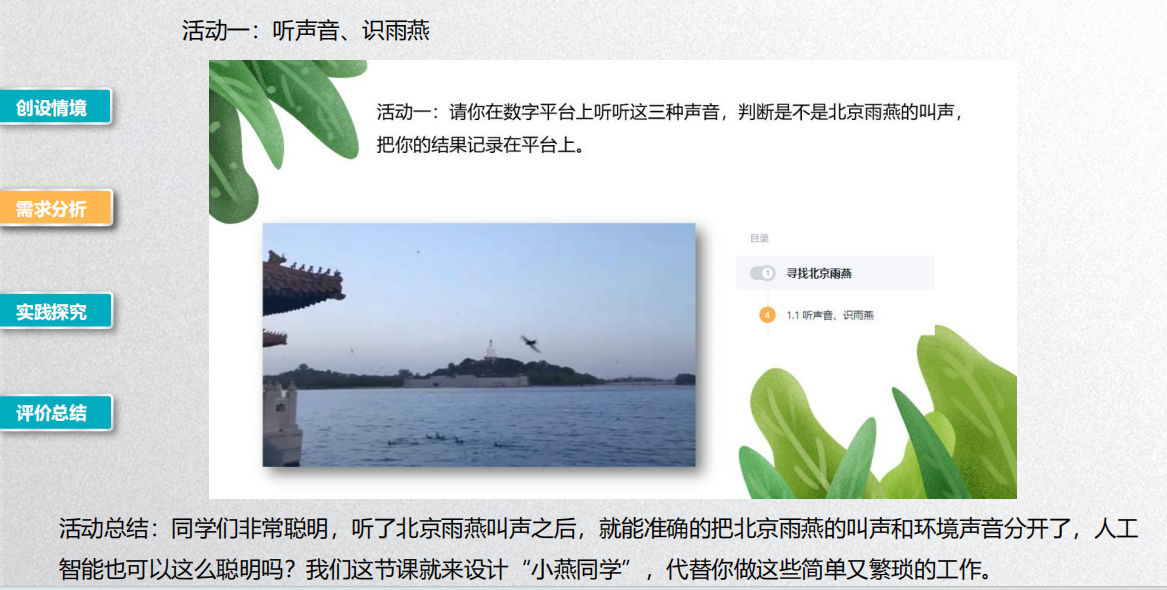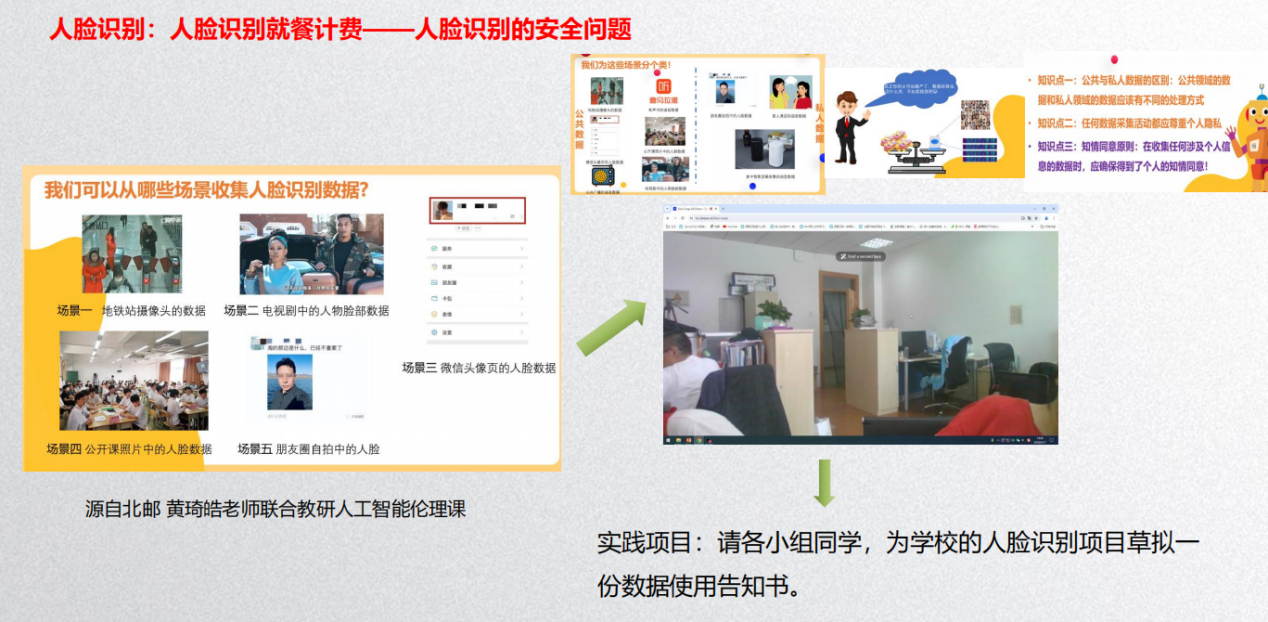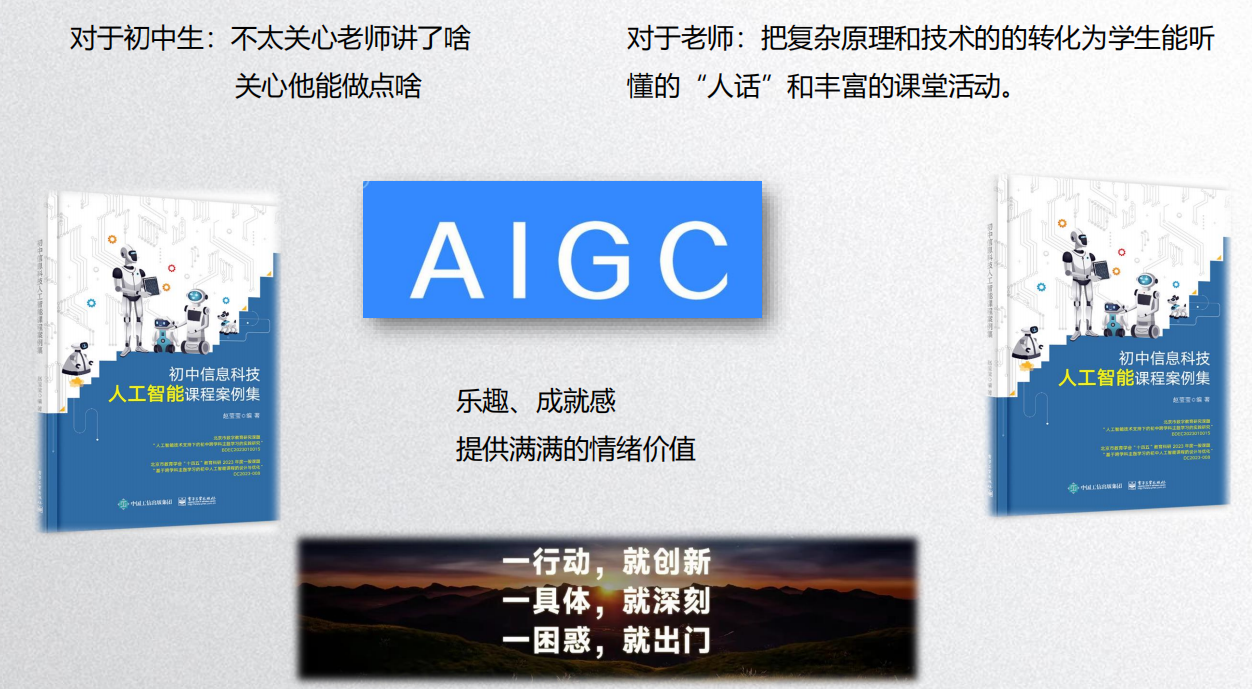[Yuanzhuo Academy] Design and Practice of Artificial Intelligence Courses for Junior High Schools
date:2024-07-04 15:20author:adminsource:Smart Learning Instituteviews:
On the morning of June 22, 2024, Yuanzhuo Academy invited Zhao Yingying, an information technology teacher at the Branch of Beijing No. 5 Middle School, to share the design and practice of junior high school artificial intelligence courses. This session focused on the design, implementation effect evaluation and case analysis of the artificial intelligence courses in junior high school.
This event discussed how to integrate the current development of artificial intelligence technology with the learning condition of junior high school students according to the requirements of the new curriculum standards to create artificial intelligence course content that is full of life and fun. At the same time, it revealed how to integrate technology and education deeply, transforming complex theories into vivid teaching.
In addition, the event also discussed how digital technology can help improve classroom participation and promote the integration of teaching and assessment and analyzed two typical cases of model training and experience. Finally, it briefly introduces how to use case collection to assist teachers in teaching implementation.
1. Artificial intelligence course design in junior high schools
In course design, Ms. Zhao emphasized the concept of cultivating students’ core competencies, including information awareness, computational thinking, and responsibility in the information society, etc. When screening course content, Ms. Zhao preferred to introduce currently mature artificial intelligence technologies, such as computer vision and speech technology, and cleverly integrated these cutting-edge technologies into students’ daily lives.
In innovating teaching methods, Ms. Zhao was ingenious in choosing graphical model training software to reduce the difficulty for students in learning programming. At the same time, she focused on in-depth explanations and practical explorations of scientific principles to stimulate students’ interest in learning and classroom participation.
In addition, her curriculum design also incorporated cases that are closely related to everyday life, such as the application of voice butler and voiceprint recognition technology, etc. These cases enable students to experience the practical value of artificial intelligence and fit the requirements of the new curriculum standard in the meantime.

2. Quality assessment of artificial intelligence teaching in junior high schools
At this stage, Ms. Zhao used the methodology in action research to analyze each aspect of the course implementation, which not only provided insight into the effectiveness of the teaching methods but also laid a solid foundation for the continuous optimization of the course. At the same time, she conducted in-depth interviews to directly obtain students’ real feedback on course content and teaching methods. She also used questionnaires to quantitatively evaluate students’ learning outcomes and widely collect opinions to provide strong data support for teaching effectiveness.

3. Case analysis on artificial intelligence teaching in junior high schools
Case 1: Searching for Beijing Swifts
In this case, Ms. Zhao guides students in understanding the application of artificial intelligence in ecological protection and experiencing the process of machine learning through the practice of sound classification models. It not only imparts knowledge of artificial intelligence technology but also enhances students’ awareness of biodiversity protection.

Case 2: Facial Recognition in Dining Billing
In this case, students intuitively understand facial recognition technology and achieve a leap from theory to practice through functional analysis and logical analysis of the program. Students can not only learn the application of technology but also discuss the ethical and safety issues behind it and cultivate a sense of social responsibility and critical thinking.

4. Guidelines for the use of Casebook on Artificial Intelligence Curriculum for IT in Junior High Schools
In this section, Ms.Zhao briefly introduced the guidelines for the use of the Casebook on Artificial Intelligence Curriculum for IT in Junior High Schools for teachers’ teaching implementation. Casebook on Artificial Intelligence Curriculum for IT in Junior High Schools guides teachers to fully understand projects, clarify teaching goals and directions, sort out key concepts, and provide resources for in-depth learning. The well-designed teaching activity flow chart clearly shows the teaching steps, helping teachers organize the class in an orderly manner. In addition, it introduces questioning methods, discussion strategies and how to use digital resources like micro-class videos to enrich teaching content.

5. Q&A session
Q: How is interdisciplinary teaching achieved and does it require the involvement of faculty from more than one discipline?
A: Interdisciplinary theme-based learning should be conducted based on the standpoints of individual disciplines but does not necessarily require multiple teachers to teach at the same time. During the teaching and research process, teachers of different disciplines can jointly design a curriculum based on the characteristics and needs of their own disciplines. For example, when exploring the Beijing Swifts project, the biology teacher can explain it from the perspective of its physiological structure, the IT teacher can be responsible for the application of monitoring technology, and the labour class teacher can design the relevant artificial structure. The key is for each teacher to have a clear disciplinary stance and to utilize his or her expertise in curriculum design.
Q: How to allocate class hours for information technology courses and artificial intelligence courses?
A: At the junior high school level, students take IT classes in the first and second semesters. The first semester of the first year focuses on bridging primary and junior high school, covering the basics of programming; the second semester of the first year and the first semester of the second year cover the Internet of Things; and the second semester of the second year covers Artificial Intelligence. Each topic is allotted a semester for in-depth study, and each semester consists of approximately 16 classroom hours in a consecutive classroom format so that students are able to delve deeper into their projects.
Q: How do you balance the ratio of theory to practice in your program?
A: There is no fixed standard for the ratio of theory to practice. I recommend that theory should be approximately 30% and practice 70%. In IT courses, principles are as important to explain as they are to practice, but they need to be transformed into interesting classroom activities which students can understand, avoiding boring theoretical lectures.
Q: What is the difference between large-unit teaching and project-based learning?
A: Project-based learning is usually based on an authentic problem that leads to in-depth inquiry. Large-unit teaching, on the other hand, expands a topic or problem into a larger instructional unit that may contain multiple related projects. In Beijing, large-unit teaching is more popular because it allows teachers to reintegrate course content based on authentic problems and to integrate teaching across disciplines.
Q: How can we ensure that students get enough hands-on opportunities in the classroom?
A: Designing engaging classroom activities ensures that students are able to understand the principles while practicing and applying them.
Q: Are artificial intelligence courses appropriate for elementary school students?
A: I generally teach junior high school courses. Some of the experiential examples in the book, such as the Little Stewards project, are appropriate for upper elementary students. These programs usually have a low threshold and are easy for elementary students to understand and work with.
Q: How do I know about the specific use and access to AI box software?
A: AI box software is used for sound modelling, and the small bookmark that comes with the book contains instructions on how to download the software, the trial code, and contact information.
Q: How are IT courses assessed?
A: Instead of being assessed by traditional exams, IT courses are usually evaluated through project completion and student performance.
This event discussed how to integrate the current development of artificial intelligence technology with the learning condition of junior high school students according to the requirements of the new curriculum standards to create artificial intelligence course content that is full of life and fun. At the same time, it revealed how to integrate technology and education deeply, transforming complex theories into vivid teaching.
In addition, the event also discussed how digital technology can help improve classroom participation and promote the integration of teaching and assessment and analyzed two typical cases of model training and experience. Finally, it briefly introduces how to use case collection to assist teachers in teaching implementation.
1. Artificial intelligence course design in junior high schools
In course design, Ms. Zhao emphasized the concept of cultivating students’ core competencies, including information awareness, computational thinking, and responsibility in the information society, etc. When screening course content, Ms. Zhao preferred to introduce currently mature artificial intelligence technologies, such as computer vision and speech technology, and cleverly integrated these cutting-edge technologies into students’ daily lives.
In innovating teaching methods, Ms. Zhao was ingenious in choosing graphical model training software to reduce the difficulty for students in learning programming. At the same time, she focused on in-depth explanations and practical explorations of scientific principles to stimulate students’ interest in learning and classroom participation.
In addition, her curriculum design also incorporated cases that are closely related to everyday life, such as the application of voice butler and voiceprint recognition technology, etc. These cases enable students to experience the practical value of artificial intelligence and fit the requirements of the new curriculum standard in the meantime.

2. Quality assessment of artificial intelligence teaching in junior high schools
At this stage, Ms. Zhao used the methodology in action research to analyze each aspect of the course implementation, which not only provided insight into the effectiveness of the teaching methods but also laid a solid foundation for the continuous optimization of the course. At the same time, she conducted in-depth interviews to directly obtain students’ real feedback on course content and teaching methods. She also used questionnaires to quantitatively evaluate students’ learning outcomes and widely collect opinions to provide strong data support for teaching effectiveness.

Case 1: Searching for Beijing Swifts
In this case, Ms. Zhao guides students in understanding the application of artificial intelligence in ecological protection and experiencing the process of machine learning through the practice of sound classification models. It not only imparts knowledge of artificial intelligence technology but also enhances students’ awareness of biodiversity protection.

Case 2: Facial Recognition in Dining Billing
In this case, students intuitively understand facial recognition technology and achieve a leap from theory to practice through functional analysis and logical analysis of the program. Students can not only learn the application of technology but also discuss the ethical and safety issues behind it and cultivate a sense of social responsibility and critical thinking.

4. Guidelines for the use of Casebook on Artificial Intelligence Curriculum for IT in Junior High Schools
In this section, Ms.Zhao briefly introduced the guidelines for the use of the Casebook on Artificial Intelligence Curriculum for IT in Junior High Schools for teachers’ teaching implementation. Casebook on Artificial Intelligence Curriculum for IT in Junior High Schools guides teachers to fully understand projects, clarify teaching goals and directions, sort out key concepts, and provide resources for in-depth learning. The well-designed teaching activity flow chart clearly shows the teaching steps, helping teachers organize the class in an orderly manner. In addition, it introduces questioning methods, discussion strategies and how to use digital resources like micro-class videos to enrich teaching content.

5. Q&A session
Q: How is interdisciplinary teaching achieved and does it require the involvement of faculty from more than one discipline?
A: Interdisciplinary theme-based learning should be conducted based on the standpoints of individual disciplines but does not necessarily require multiple teachers to teach at the same time. During the teaching and research process, teachers of different disciplines can jointly design a curriculum based on the characteristics and needs of their own disciplines. For example, when exploring the Beijing Swifts project, the biology teacher can explain it from the perspective of its physiological structure, the IT teacher can be responsible for the application of monitoring technology, and the labour class teacher can design the relevant artificial structure. The key is for each teacher to have a clear disciplinary stance and to utilize his or her expertise in curriculum design.
Q: How to allocate class hours for information technology courses and artificial intelligence courses?
A: At the junior high school level, students take IT classes in the first and second semesters. The first semester of the first year focuses on bridging primary and junior high school, covering the basics of programming; the second semester of the first year and the first semester of the second year cover the Internet of Things; and the second semester of the second year covers Artificial Intelligence. Each topic is allotted a semester for in-depth study, and each semester consists of approximately 16 classroom hours in a consecutive classroom format so that students are able to delve deeper into their projects.
Q: How do you balance the ratio of theory to practice in your program?
A: There is no fixed standard for the ratio of theory to practice. I recommend that theory should be approximately 30% and practice 70%. In IT courses, principles are as important to explain as they are to practice, but they need to be transformed into interesting classroom activities which students can understand, avoiding boring theoretical lectures.
Q: What is the difference between large-unit teaching and project-based learning?
A: Project-based learning is usually based on an authentic problem that leads to in-depth inquiry. Large-unit teaching, on the other hand, expands a topic or problem into a larger instructional unit that may contain multiple related projects. In Beijing, large-unit teaching is more popular because it allows teachers to reintegrate course content based on authentic problems and to integrate teaching across disciplines.
Q: How can we ensure that students get enough hands-on opportunities in the classroom?
A: Designing engaging classroom activities ensures that students are able to understand the principles while practicing and applying them.
Q: Are artificial intelligence courses appropriate for elementary school students?
A: I generally teach junior high school courses. Some of the experiential examples in the book, such as the Little Stewards project, are appropriate for upper elementary students. These programs usually have a low threshold and are easy for elementary students to understand and work with.
Q: How do I know about the specific use and access to AI box software?
A: AI box software is used for sound modelling, and the small bookmark that comes with the book contains instructions on how to download the software, the trial code, and contact information.
Q: How are IT courses assessed?
A: Instead of being assessed by traditional exams, IT courses are usually evaluated through project completion and student performance.
The replay of this event and related resources have been uploaded to the Yuanzhuo Planning Resource platform:
https://yuanzhuo.bnu.edu.cn/course/232
https://yuanzhuo.bnu.edu.cn/course/232

